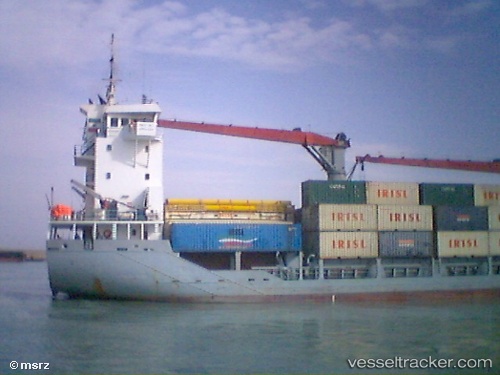
Iran is using its sea power in the Gulf to show it will not be cowed by Washington’s newly assertive Arab allies, prompting critics to accuse Tehran of destabilizing the region.
Iranian ships fired shots at a Singapore-flagged tanker which it said damaged an Iranian oil platform, causing the vessel to flee, and seized a container ship in the Strait of Hormuz, the world’s most important oil route, over a debt row.
The incidents coincided with a push by Washington to reassure Gulf Arab monarchies that their interests would not be threatened by a nuclear accord that Tehran and world powers are trying to reach by the end of June.
In an escalating confrontation with Saudi Arabia over Yemen, Tehran criticized Arab states for recklessness and brutality in that country, where a Saudi-led coalition is attacking an Iranian-allied militia.
Iran has also sent an aid ship, the Iran Shahed, to the Yemeni Red Sea port of Hodaida to test a naval blockade enforced by the coalition. Several Iranian military officials have warned of war if the Iran Shahed is attacked by Saudi-led forces. It expected to reach the port by Thursday.
“Iran’s recent measures in the Strait of Hormuz have one clear message to Saudi Arabia. No one can ignore Iran’s key role,” said an Iranian official, who asked not to be named due to the sensitivity of the issue.
“Whether reformist or hardliner, Iranian leaders have consensus on securing Iran’s influence in the region,” said the official.
“They (the United States and its Gulf allies) don’t expect a key regional power like Iran to remain silent over its aid ship being prevented from entering Yemen.”
Tehran and Riyadh have long been locked in a proxy war, competing for regional supremacy from Iraq to Syria and Lebanon to Yemen, where Riyadh backs Yemen’s exiled government against Iranian-backed Houthi rebels.
In a bold operation by Gulf Arab states, the Saudi-led coalition backed by the West on March 26 began pounding Houthi rebels and allied army units that control much of Yemen as well as inspecting all ships in a bid to stop weapons smuggling.
Tehran denies training Houthi fighters and supplying arms, as claimed by Riyadh. The standoff has intensified since the coalition declared that it had to inspect all aid for Yemen including that sent by Tehran.
TESTING THE LIMITS
Iran has been cautious about direct military confrontation with Saudi Arabia. “Riyadh is trying to drag Iran into a military conflict,” said a senior Iranian security official.
“The Saudis are pursuing a very dangerous path … We are strong enough to confront them … but we prefer political solutions, for now.”
Iran’s maritime operations have brought a new dimension to the stand-off between Tehran and Riyadh, and officials and analysts say they clearly mark a renewed drive to wield regional influence.
Last week five Iranian Revolutionary Guard Corps patrol boats fired shots at the Singapore-flagged Alpine Eternity oil products tanker in the Gulf, U.S. officials said. It fled to safety in the United Arab Emirates’ waters.
The Maritime and Port Authority of Singapore on Monday called on Iranian authorities to investigate the incident and “prevent future recurrences”.
“Such interference with navigational rights is a serious violation of international law,” the authority said.
Earlier this month, Iran released the Marshall-Islands flagged container ship Maersk Tigris, seized in the Strait of Hormuz over a years-old debt, after security was put up by Denmark’s Maersk Line, the ship’s charterer.
Shipping underwriters said that the commercial pretext for such activity could lead to a spike in shipping costs. U.S. officials acknowledged concerns among Gulf partners about Iran’s maritime conduct.
The diverting of the Maersk Tigris on April 28 prompted the United States to send vessels temporarily to escort U.S.-flagged ships through the strait.
Denmark’s Foreign Minister Martin Lidegaard said his country hoped “similar cases will not occur in the future”.
Iranian ships shadowed the U.S.-flagged Maersk Kensington on April 24. The Pentagon said at the time the incidents showed “a pattern of harassment”.
AN EMBOLDENED TEHRAN?
On two previous occasions, in 2008 and 2010, Iran threatened to disrupt oil flow in the Gulf by shutting the Strait of Hormuz if there were any military strike on its nuclear sites.
Millions of barrels of oil are transported daily through the Bab el-Mandeb and Strait of Hormuz to Europe, the United States and Asia, waterways which pass the coasts of Yemen and Iran.
Iran, the United States, France, Germany, Russia and China are in talks aimed at clinching a long-term deal by June 30 to curb Tehran’s nuclear program in exchange for an end to sanctions.
Saudi Arabia and its Gulf allies fear that the nuclear deal might embolden Tehran to deepen its influence in the Middle East and step up its efforts to dominate Arab countries such as Lebanon, Syria and Iraq.
They are concerned that lifting sanctions would also give Tehran a cash windfall to increase funding to Shi’ite militias in countries like Syria, Yemen and Iraq.
Commenting on Iran’s display of sea power, regional analysts said Washington’s priority is to stop Iran developing an atomic bomb and halt expansion of the Sunni jihadis of Islamic State.
“Gulf shipping is not as much of a priority for the U.S. as is getting a deal over stopping nuclear weapon development,” said Michael Frodl, of U.S. based consultancy C-Level Global Risks, referring to Iran’s flexing its muscles in the Gulf.
“So Iran is testing the limits.”
REUTERS
Leave a Reply
You must be logged in to post a comment.